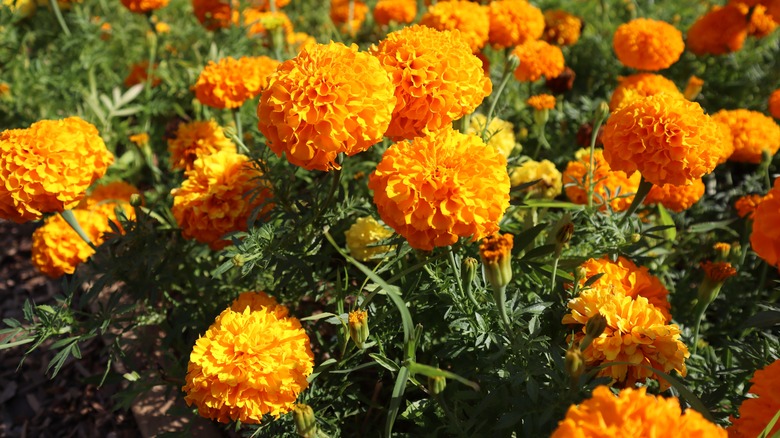Moles are pesky problem-causers in your yard that commonly create holes in the ground and damage plants. Using marigolds (Tagetes) could be a simple way to keep these pests out and add something beautiful to your yard. Marigolds may look pretty, but they have a strong scent that makes them a natural deterrent for pests, including moles. They don’t harm the moles but instead repel them, discouraging them from making your garden their home.
The marigold flower, noted for its gold and brass-colored petals and tight-rounded formation, tends to bloom from spring through fall, which means they continue to create a strong scent for many months. As long as you deadhead the flowers throughout the year, you’ll keep them blooming and working to deter pests from the surrounding space. Plant them around the exterior of a garden or flower bed where you know there has been mole activity for the best results.
Though there are over 50 species of marigold flowers, choosing varieties that work well in your climate and create the look you desire is best. Most grow easily in any type of soil, but they require well-drained soil to really thrive. Add some organic compost to get the most blooms throughout the season. Because marigolds are a low-maintenance flower, this is one of the easiest hacks for repelling moles. In fact, it could be considered one of the best ways to get rid of moles in your garden.
Why marigold flowers keep moles away

Marigold flowers repel moles for several reasons, mostly due to the strong scent of the bloom itself. Moles, who are always looking for a food source based on smell, are drawn to organic products with an edible scent. The pungent aroma of marigolds does not appeal to them, which means that they are less likely to move in their direction as they seek out a new food source. While moles aren’t blind, they have limited vision and rely on their sense of scent to track down food sources. The intensity of the marigold flowers, then, is unappealing to them. They also cannot smell any food sources in the area due to the flower’s powerful scent that can mask other odors.
In addition to this, marigolds are not a food moles can eat because they are not digestible to them. Even if they’ve eaten their way through other plants in the area in their search for insects, they won’t go near these yellow blooms. Finally, marigolds work so well as a deterrent for burrowing moles because the flowers’ root system releases alpha-terthienyl and methyl isothiocyanate. These are natural compounds that help support the root’s health and growth. However, the compounds are harmful to pests who eat the surrounding dirt or the roots themselves. While this can be toxic, it’s not likely the moles will eat it in the first place, minimizing the risk of poisoning them and simply working more as a repellent.
How to use marigold flowers in your garden to repel moles
There’s little doubt that the yellow and orange hues of marigolds create an impactful statement in flower beds, but not many people realize the benefit of putting them directly in the garden. If you have flowering vegetables and fruits in your garden, plant marigolds along entrance areas where moles and other pests can enter to create a border. You could also create a line of flowers between your garden produce plants or group several in key areas to create a strong, wafting scent.
You can choose any type of marigold that works well in your area, but two species have the most impactful scent. Mexican marigold is one type that’s noted for its smaller flower heads that add tiny pops of color to the garden. French marigold is another popular option with larger and more orange-colored flowers. Both work well to keep moles from invading a garden space.
However, if you already have a mole problem in your garden, the presence of marigolds alone may not be enough to get them to leave. Consider trapping them first with a live trap system and then relocating them outside the yard. There are other natural mole treatment options, but when the problem is significant and you’ve begun to notice their holes and tunnels, it may be best to call a professional to remove them.
